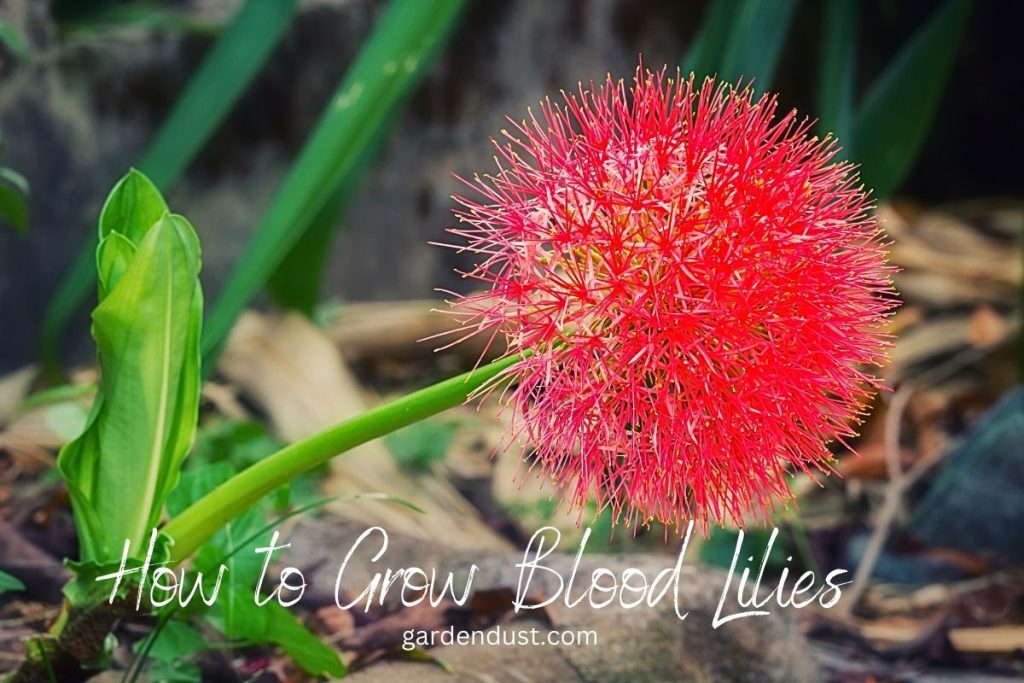Blood Lilies (Haemanthus spp.) are captivating flowering plants known for their striking red blooms and bold, tropical appearance. With their unique charm and relatively low-maintenance nature, these plants make a perfect addition to gardens or indoor spaces. In this comprehensive guide, we will explore the steps to successfully How to Grow and Care for Blood Lilies, ensuring you can enjoy their vibrant beauty year-round. Let’s start….
Botanical Name- Haemanthus spp.
Common Name-Blood Lilies
Native-Africa
Genus-Haemanthus
Family-Amaryllidaceae
Flower Color-Red blooms
Plant Type-Herbaceous perennial plants
Plant Size-Up to two feet
Blooming Time-Late spring to early summer
Care For Blood Lilies
Sunlight Requirement
Blood Lilies (Haemanthus spp.) thrive in locations with filtered sunlight or partial shade. While they appreciate some sunlight, especially during their active growing season, it’s crucial to avoid planting them in areas with direct, harsh sunlight. Providing a balance of light and shade ensures optimal growth and helps prevent issues like leaf burn.
Fertilizer
For robust growth and vibrant blooms, Blood Lilies benefit from regular fertilization. Use a balanced, water-soluble fertilizer with equal parts nitrogen (N), phosphorus (P), and potassium (K), such as a 10-10-10 formulation. Apply the fertilizer every 4-6 weeks during the growing season, which typically spans from spring to early summer. This feeding regimen provides the necessary nutrients for healthy foliage and stunning flowering displays.
Water
Blood Lilies prefer consistent moisture, especially during their active growth period. Water the plants when the top inch of soil feels dry to the touch, ensuring that the soil is adequately moist without being waterlogged. During the dormant period, typically in late fall and winter, reduce watering to allow the soil to dry out between waterings. Proper watering practices help prevent issues like root rot and maintain the overall health of the bulbs.
Soil Preparation
Preparing well-draining soil is crucial for the success of Blood Lilies. Incorporate organic matter such as compost or well-rotted manure into the soil to improve fertility and drainage. Aim for a slightly acidic to neutral pH range, ideally between 6.0 and 7.0. This ensures that the bulbs have an optimal environment for root development and nutrient absorption. Good soil preparation sets the foundation for healthy growth and robust blooming.
Location
Selecting the right location is vital for the well-being of Blood Lilies. Choose an area with well-draining soil, avoiding waterlogged conditions that can lead to bulb rot. Plant the bulbs with about one-third of the bulb above the soil surface to prevent rotting. Additionally, provide a location with proper air circulation to discourage fungal diseases. Blood Lilies can be grown both outdoors in garden beds and indoors in containers, making them versatile additions to various spaces. Whether in a garden or a container, ensuring the right environmental conditions contributes to the overall success of cultivating these captivating plants.
READ ALSO:-How To Grow Daylily
Growing Blood Lilies from Seeds
Growing Blood Lilies (Haemanthus spp.) from seeds is a rewarding process. Use fresh seeds and sow them twice their diameter deep in a well-draining soil mix. Keep the soil consistently moist and provide indirect sunlight. Germination may take several weeks. Once seedlings have developed, transplant them into pots or the garden. While this method requires patience, it offers a unique way to cultivate Blood Lilies from their early stages, eventually leading to the emergence of their stunning red blooms.
Propagation of Blood Lilies
Blood Lilies (Haemanthus spp.) can be propagated through several methods, with division and offsets being the most common. Division is a straightforward technique often employed when the plant becomes overcrowded or to create new plants. During the active growing season, typically in spring, carefully lift the bulbs from the soil. Using a sharp, clean knife, divide the bulbs, ensuring each division has both roots and shoots. These divisions can then be replanted following the same guidelines as the initial planting. Additionally, some species of Blood Lilies produce offsets or bulbils around the base of the parent bulb. These offsets can be gently separated and planted individually to establish new plants. Whether through division or offsets, Blood Lilies readily propagate, allowing for the expansion of their vibrant presence in gardens or indoor settings.
Common Problems with Blood Lilies
Blood Lilies (Haemanthus spp.) may encounter common issues affecting their health. Yellowing leaves signal potential overwatering, underwatering, or nutrient deficiencies, requiring adjustments to the care routine. Lack of blooms may result from inadequate sunlight, incorrect planting depth, or stressed bulbs, emphasizing the importance of proper planting and light exposure. Soft or rotten bulbs may indicate excess moisture, necessitating improved drainage. Pests like spider mites can be controlled with insecticidal soap, and fungal diseases can be prevented with proper spacing and watering practices. Addressing these issues promptly ensures the sustained vibrancy and well-being of Blood Lilies.
Successfully growing and caring for Blood Lilies involves understanding their specific needs and providing the right conditions. With proper planting, watering, fertilizing, and occasional maintenance, you can enjoy the stunning, blood-red blooms of these unique plants in your garden or indoor space. By following the guidelines outlined in this comprehensive guide, you’ll be well-equipped to cultivate thriving Blood Lilies that add a touch of tropical elegance to your botanical collection. Happy Gardening…
Few FAQ about Blood Lilies (Haemanthus spp.)
1. What is the best time to plant Blood Lilies?
Blood Lilies are best planted in spring when they are entering their active growing season. This timing allows them to establish well before their blooming period in late spring to early summer.
2. How do I care for Blood Lilies during the dormant period?
During the dormant period, typically in late fall and winter, reduce watering to allow the soil to dry out between waterings. Protect them from frost, especially in colder climates, and consider bringing potted plants indoors.
3. Can Blood Lilies be grown indoors?
Yes, Blood Lilies can be grown indoors in containers. Ensure they receive bright, indirect light, and maintain a well-draining soil mix. Adequate humidity and proper watering are essential for indoor cultivation.
4. Why are my Blood Lily leaves turning yellow?
Yellowing leaves may indicate overwatering, underwatering, or nutrient deficiencies. Adjust your watering routine, ensure proper drainage, and consider fertilizing to address nutrient imbalances.
5. How do I propagate Blood Lilies?
Blood Lilies can be propagated through division or by using offsets. Divide the bulbs during the active growing season, ensuring each division has roots and shoots. Alternatively, plant offsets produced around the base of the parent bulb.
6. What is the ideal sunlight exposure for Blood Lilies?
Blood Lilies prefer filtered sunlight or partial shade. Avoid direct, harsh sunlight, especially during the hottest parts of the day, to prevent issues like leaf burn.
7. How do I protect Blood Lilies from pests?
Keep an eye out for pests like spider mites. Regularly inspect the undersides of leaves and treat infestations with insecticidal soap or neem oil following product instructions.
8. Can I grow Blood Lilies in colder climates?
Blood Lilies are generally not frost-tolerant. In colder climates, consider planting them in containers that can be brought indoors during winter or provide frost protection with a thick layer of mulch.
9. How often should I fertilize Blood Lilies?
Fertilize Blood Lilies every 4-6 weeks during their active growing season with a balanced, water-soluble fertilizer. Avoid fertilizing during the dormant period.
10. Do Blood Lilies have any specific soil requirements?
Blood Lilies prefer well-draining soil with added organic matter. Aim for a slightly acidic to neutral pH (around 6.0 to 7.0) for optimal growth and development.







